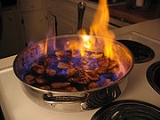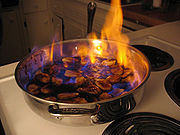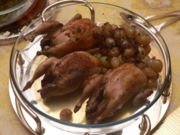
Flambé
Encyclopedia


- Flambé is also a type of ceramic glazeCeramic glazeGlaze is a layer or coating of a vitreous substance which has been fired to fuse to a ceramic object to color, decorate, strengthen or waterproof it.-Use:...
.
Flambé (icon, flɑ̃be; also spelled flambe) is a cooking
Cooking
Cooking is the process of preparing food by use of heat. Cooking techniques and ingredients vary widely across the world, reflecting unique environmental, economic, and cultural traditions. Cooks themselves also vary widely in skill and training...
procedure in which alcohol
Ethanol
Ethanol, also called ethyl alcohol, pure alcohol, grain alcohol, or drinking alcohol, is a volatile, flammable, colorless liquid. It is a psychoactive drug and one of the oldest recreational drugs. Best known as the type of alcohol found in alcoholic beverages, it is also used in thermometers, as a...
is added to a hot pan to create a burst of flames. The word means flamed in French
French language
French is a Romance language spoken as a first language in France, the Romandy region in Switzerland, Wallonia and Brussels in Belgium, Monaco, the regions of Quebec and Acadia in Canada, and by various communities elsewhere. Second-language speakers of French are distributed throughout many parts...
(thus, in French, flambé is a past participle; the verb is flamber).
It is typically done to create an impressive visual presentation at a dramatic point in the preparation of a meal. The flames result from the partial combustion
Combustion
Combustion or burning is the sequence of exothermic chemical reactions between a fuel and an oxidant accompanied by the production of heat and conversion of chemical species. The release of heat can result in the production of light in the form of either glowing or a flame...
of the flammable alcohol, which is quickly consumed, subsequently extinguishing the flames (some alcohol content remains).
Although the practice of igniting food for show can be traced to the Moors
Moors
The description Moors has referred to several historic and modern populations of the Maghreb region who are predominately of Berber and Arab descent. They came to conquer and rule the Iberian Peninsula for nearly 800 years. At that time they were Muslim, although earlier the people had followed...
in the 14th century, modern flambéing became popular only in the late 19th century. According to his own story, it was discovered in Monte Carlo
Monte Carlo
Monte Carlo is an administrative area of the Principality of Monaco....
in 1895, when Henri Carpentier, a waiter, accidentally set fire to a pan of crêpe
Crêpe
A crêpe or crepe , is a type of very thin pancake, usually made from wheat flour or buckwheat flour . The word is of French origin, deriving from the Latin crispa, meaning "curled". While crêpes originate from Brittany, a region in the northwest of France, their consumption is widespread in France...
s he was preparing for the future Edward VII of the United Kingdom
Edward VII of the United Kingdom
Edward VII was King of the United Kingdom and the British Dominions and Emperor of India from 22 January 1901 until his death in 1910...
. He discovered that burning the sauce affected its flavor in a way that he could not have anticipated. Larousse Gastronomique
Larousse Gastronomique
Larousse Gastronomique is an encyclopedia of gastronomy. The majority of the book is about French cuisine, and contains recipes for French dishes and cooking techniques...
, however, disputes this story (see Crêpe Suzette
Crêpe Suzette
Crêpe Suzette is a French dessert consisting of a crêpe with beurre Suzette, , a sauce of caramelized sugar and butter, tangerine or orange juice, zest, and Grand Marnier or orange Curaçao liqueur on top, served flambé.-Preparation:...
for details).
Simply lighting food on fire is not flambéing in and of itself. Igniting a sauce with alcohol in the pan changes the chemistry of the food. Because alcohol boils at 78 °C (172 °F), water boils at 100 °C (212 °F) and sugar
Sugar
Sugar is a class of edible crystalline carbohydrates, mainly sucrose, lactose, and fructose, characterized by a sweet flavor.Sucrose in its refined form primarily comes from sugar cane and sugar beet...
caramelizes
Caramelization
Caramelization is the browning of sugar, a process used extensively in cooking for the resulting nutty flavor and brown color. As the process occurs, volatile chemicals are released, producing the characteristic caramel flavor....
at 160 °C (320 °F), ignition of all these ingredients combined results in a complex chemical reaction, especially as the surface of the burning alcohol exceeds 240 °C (500 °F). However, because taste is a very subjective sense, not everyone can discern a change in flavor as a result of flambéing. Some claim that because the flame is above the food and since hot gases rise, it cannot significantly affect the flavor, although in an informal taste test
Taste Test
Taste Test may refer to:*"Taste Test", a song by Sleater-Kinney from their 1996 album Call the Doctor*Blind wine tasting, a wine taste test involving no knowledge of the wine's identity on the part of the tasters...
conducted by the Los Angeles Times
Los Angeles Times
The Los Angeles Times is a daily newspaper published in Los Angeles, California, since 1881. It was the second-largest metropolitan newspaper in circulation in the United States in 2008 and the fourth most widely distributed newspaper in the country....
of two batches of caramelized apples (one flambéed and one simmered
Simmering
Simmering is a food preparation technique in which foods are cooked in hot liquids kept at or just below the boiling point of water , but higher than poaching temperature...
), one tester declared the "flambéed dish was for adults, the other for kids." Others, however, dispute this and quote celebrated French chefs who claim that flambéing is strictly a show-biz aspect of restaurant business and ruins food.
Because of their high alcohol content, in the United States, many low end restaurants flambé with liquors such as Everclear
Everclear (alcohol)
Everclear is a brand of neutral grain spirit manufactured by Luxco . Everclear is relatively low in congeners and is available in concentrations of 151- and 190-proof, which are 75.5 and 95 percent alcohol, respectively...
or 151
Bacardi 151
Bacardi 151 is an over-proof rum. The 151-proof liquor has an alcohol content of 75.5%, compared to the usual 35%-40%.Due to its high proof, it is typically used as a component in cocktails...
. However, these spirits are highly flammable and are considered much too dangerous by other restaurants. Wine
Wine
Wine is an alcoholic beverage, made of fermented fruit juice, usually from grapes. The natural chemical balance of grapes lets them ferment without the addition of sugars, acids, enzymes, or other nutrients. Grape wine is produced by fermenting crushed grapes using various types of yeast. Yeast...
s and beer
Beer
Beer is the world's most widely consumed andprobably oldest alcoholic beverage; it is the third most popular drink overall, after water and tea. It is produced by the brewing and fermentation of sugars, mainly derived from malted cereal grains, most commonly malted barley and malted wheat...
s have too little alcohol and will not flambé. Rum
Rum
Rum is a distilled alcoholic beverage made from sugarcane by-products such as molasses, or directly from sugarcane juice, by a process of fermentation and distillation. The distillate, a clear liquid, is then usually aged in oak barrels...
, cognac
Cognac (drink)
Cognac , named after the town of Cognac in France, is a variety of brandy. It is produced in the wine-growing region surrounding the town from which it takes its name, in the French Departements of Charente and Charente-Maritime....
, or other flavorful liqueur
Liqueur
A liqueur is an alcoholic beverage that has been flavored with fruit, herbs, nuts, spices, flowers, or cream and bottled with added sugar. Liqueurs are typically quite sweet; they are usually not aged for long but may have resting periods during their production to allow flavors to marry.The...
s that are about 80 USA proof (40% alcohol) are considered ideal. Cinnamon
Cinnamon
Cinnamon is a spice obtained from the inner bark of several trees from the genus Cinnamomum that is used in both sweet and savoury foods...
, which is ground from tree bark
Bark
Bark is the outermost layers of stems and roots of woody plants. Plants with bark include trees, woody vines and shrubs. Bark refers to all the tissues outside of the vascular cambium and is a nontechnical term. It overlays the wood and consists of the inner bark and the outer bark. The inner...
, is sometimes added not only for flavor, but for show as the powder ignites when added.
Safety
For safety reasons, it is recommended that alcohol never be added to a pan on a burner, and that the cook use a long fireplace match.Popular dishes
Examples of popular flambé dishes include:- Bananas FosterBananas FosterBananas Foster is a dessert made from bananas and vanilla ice cream, with the sauce made from butter, brown sugar, cinnamon, dark rum, and banana liqueur. The butter, sugar and bananas are cooked, and then the alcohol is added and ignited. The bananas and sauce are then served over the ice cream...
- Bombe Alaska
- Cherries JubileeCherries jubileeCherries jubilee is a dessert dish made with cherries and liqueur , which is subsequently flambéd, and commonly served as a sauce over vanilla ice cream....
- Crêpes Suzette
- Steak DianeSteak DianeSteak Diane is a dish consisting of a pan-fried filet mignon with a sauce made from the seasoned pan juices. It is often flambéed at the table in restaurants. The dish takes its name from Diana the Roman goddess of the hunt.-Preparation:...

